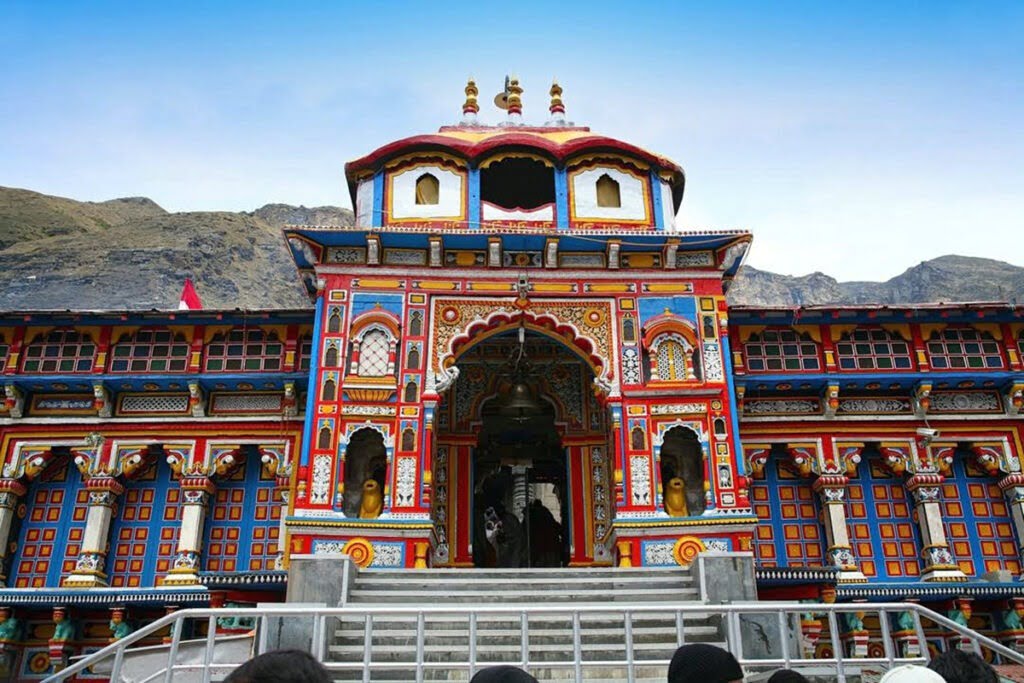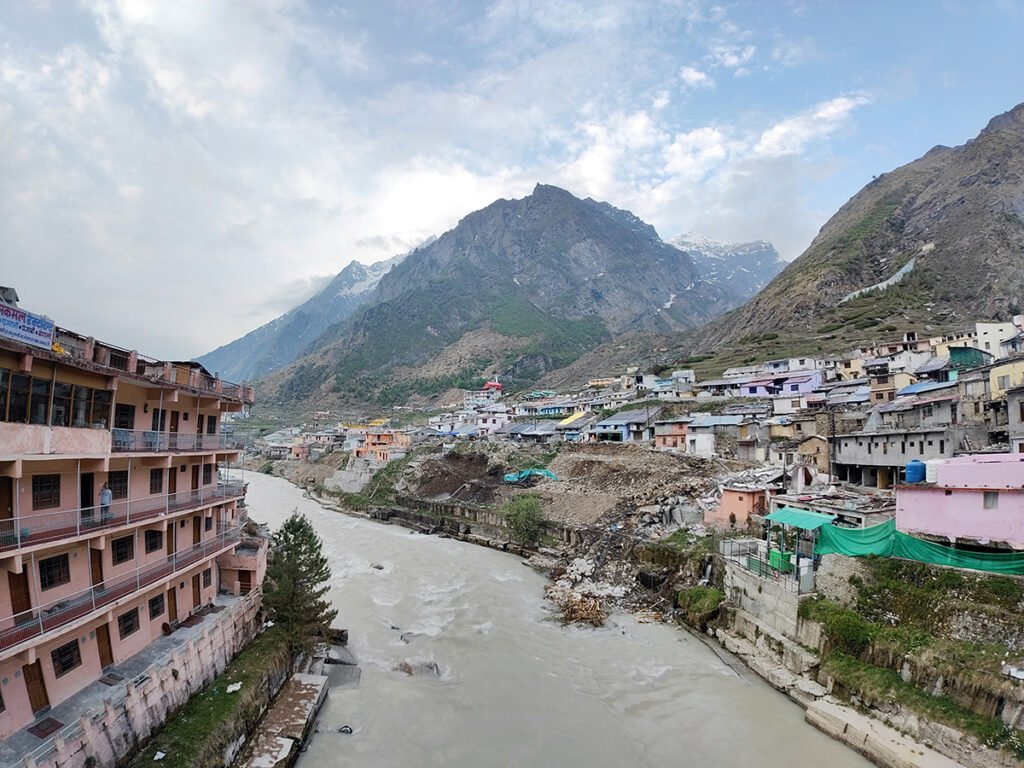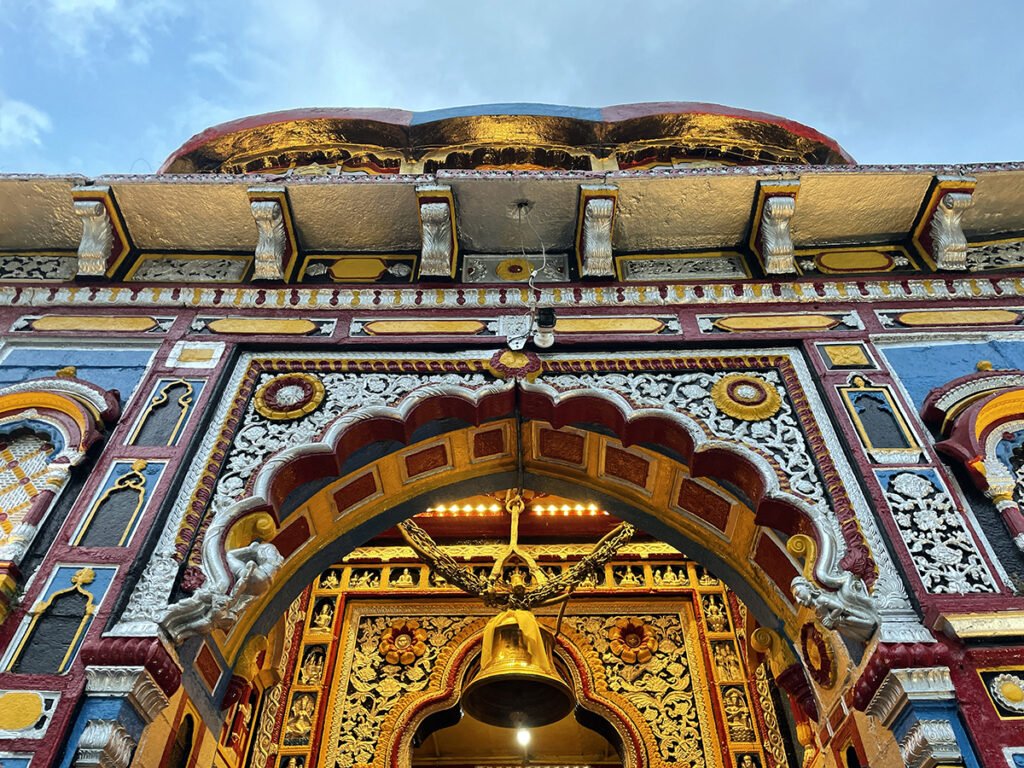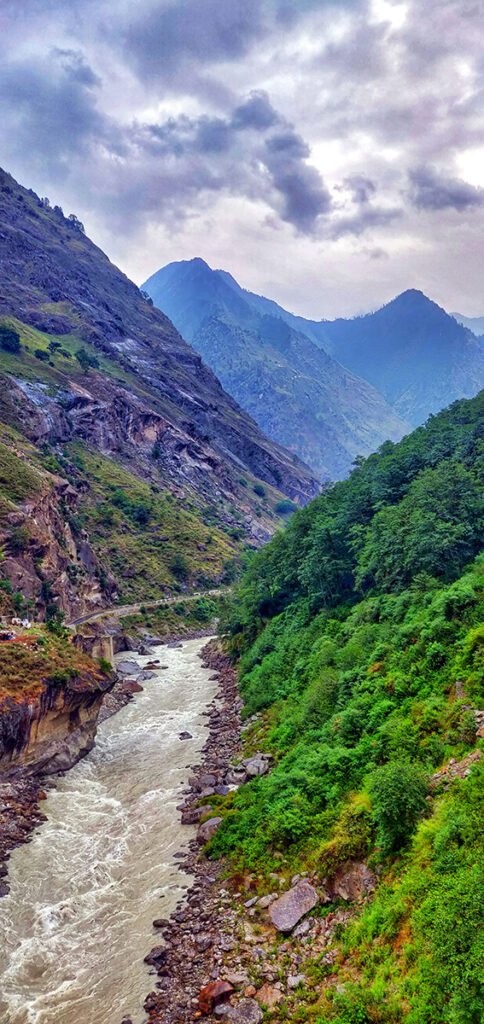Badrinath Temple | Badrinarayan Temple
Badrinath Temple, also known as the Badrinarayan Temple, is a Hindu temple dedicated to Lord Vishnu. It is located in the town of Badrinath in the state of Uttarakhand, India. The temple is one of the Char Dham pilgrimage sites and holds immense significance in Hindu mythology and religious practices.

Contents
- 1 Here are some key points about the Badrinath Temple:
- 2 HISTORY:
- 3 What is special about Badrinath Temple?
- 4 Explore More Fascinating Temples:
- 5 Badrinath temple architecture:
- 6 Badrinath temple mystery:
- 7 Interesting facts about Badrinath Temple:
- 8 Here are some other interesting facts about Badrinath Temple:
- 9 Badrinath temple darshan timings:
- 10 Places to visit near Badrinath temple:
- 11 How to reach Badrinath (all possible ways):
Here are some key points about the Badrinath Temple:
Location: The temple is situated in the Chamoli district of Uttarakhand, nestled in the Garhwal Himalayas along the banks of the Alaknanda River.
Deity: The main deity worshipped in the temple is Lord Badrinarayan, a form of Lord Vishnu. The deity is typically depicted in a meditative pose known as the “padmasana” posture.
Pilgrimage: Badrinath is one of the four Char Dham pilgrimage sites in India, along with Kedarnath, Gangotri, and Yamunotri. These four sites are considered sacred by Hindus and attract a large number of devotees each year.
Spiritual Significance: According to Hindu mythology, this mandir is believed to be the place where Lord Vishnu meditated in the form of Narayana to expiate for his past deeds. The temple is seen as a place of spiritual cleansing and salvation.
Architecture: The temple’s architecture showcases a mix of traditional Garhwali and Dravidian styles. The main temple is made of stone and features a colorful facade with intricate carvings and sculptures.
Opening and Closing Dates: The temple is open for six months each year, usually from April to November, due to the extreme weather conditions during the winter months.
Annual Festival: The Badrinath Temple holds an annual festival known as the “Badri-Kedar Festival,” which celebrates the confluence of two major Himalayan shrines: Badrinath and Kedarnath.
Access: The temple is accessible by road and is connected to other major towns and cities in Uttarakhand. Pilgrims often travel to the temple as part of a larger pilgrimage circuit.
Natural Beauty: The temple is surrounded by breathtaking natural beauty, including snow-capped peaks, lush valleys, and the serene Alaknanda River.
HISTORY:
Ancient Roots: The origins of this mandir are ancient and are mentioned in various Hindu scriptures and legends. According to some accounts, the temple’s history dates back to the Vedic period. The site is mentioned in the ancient Hindu texts like the Skanda Purana and the Vishnu Purana, where it is described as a sacred place of worship.
Adi Shankaracharya: One of the most pivotal figures in the history of the Badrinath Temple is Adi Shankaracharya, an 8th-century philosopher and theologian. He is believed to have established the current form of the temple and revived its prominence. Adi Shankaracharya is known for his efforts in reinvigorating various Hindu pilgrimage sites across India, and the Badrinath Temple is one of the prominent places associated with his legacy.
Restorations and Rebuilds: Throughout its history, this mandir has undergone several reconstructions and restorations due to natural calamities, weathering, and the passage of time. These reconstructions were often carried out by different rulers, devotees, and organizations.
Modern Times: The Badrinath Temple has continued to be a hub of spiritual activity and pilgrimage over the centuries. It is an integral part of the Char Dham Yatra, a pilgrimage circuit that includes Yamunotri, Gangotri, Kedarnath, and Badrinath. Pilgrims from various parts of India and beyond visit the temple during the six-month-long pilgrimage season, which typically runs from May to October.

What is special about Badrinath Temple?
Dedication to Lord Vishnu: The Badrinath Temple is dedicated to Lord Vishnu, specifically in his form as Badri Narayan. Lord Vishnu is considered one of the principal deities in Hinduism, and his manifestation at this site adds to the temple’s significance.
Char Dham Pilgrimage: This mandir is one of the four sacred Char Dham pilgrimage sites in India. Being a part of this revered pilgrimage circuit lends the temple a special place in the hearts of millions of Hindus who undertake this journey for spiritual purification and blessings.
Adi Shankaracharya’s Connection: Adi Shankaracharya, an eminent philosopher and saint of Hinduism, is associated with the establishment and revitalization of this mandir. His influence and spiritual guidance in this context make the temple even more special.
High Altitude Location: Situated at an elevation of around 3,415 meters (11,204 feet), the temple is located in the high Himalayas. The challenging terrain and altitude add a unique element to the pilgrimage experience, testing the devotees’ determination and dedication.
Natural Beauty: The temple’s location amidst the stunning Himalayan peaks and along the Alaknanda River contributes to its exceptional natural beauty. The surrounding landscape enhances the spiritual ambiance of the place.
Hot Springs: The presence of natural hot water springs like Tapt Kund and Narad Kund near the temple is a distinctive feature. These hot springs are not only used for ritual bathing but are also believed to have therapeutic properties.
Annual Opening and Closing Rituals: The temple’s opening and closing ceremonies mark significant events in the pilgrimage calendar. The elaborate rituals conducted during these ceremonies add to the temple’s uniqueness.
Spiritual and Cultural Confluence: The temple’s historical association with Adi Shankaracharya and its role in Hindu spirituality contribute to a rich cultural and spiritual heritage. The temple serves as a meeting point for devotees from different backgrounds and regions.

Pilgrim Amenities: Despite its remote location, the temple administration ensures that basic amenities are provided to pilgrims, including accommodation and facilities for worship. This makes it possible for devotees to undertake the pilgrimage with relative ease.
Architectural Marvel: The temple’s architecture is a blend of traditional Indian temple design and aesthetics. The intricately carved pillars, walls, and sculptures showcase the skilled craftsmanship of the artisans of that era.
Winter Closure and Reopening: The temple remains inaccessible during the harsh winter months due to heavy snowfall and extreme weather conditions. The annual ritual of closing and reopening the temple symbolizes the cyclical nature of life and the spiritual journey.
Blend of Faiths: This mandir also represents the convergence of Hindu and Sikh traditions, as the nearby Hemkund Sahib is a significant Sikh pilgrimage site. This interfaith connection adds a layer of cultural and spiritual diversity to the region.
Yoga and Meditation: The serene environment of this place makes it an ideal place for spiritual practices such as meditation and yoga. Many seekers are drawn to the tranquility of the area to deepen their spiritual experiences.
Tourism and Trekking: Apart from its religious importance, Badrinath attracts tourists and trekkers who want to explore the natural beauty and adventure opportunities in the region.
Explore More Fascinating Temples:
Kedarnath Temple: Where Faith Meets Jyotirling & Char Dham Yatra.
Subramanya Swamy Temple at Thiruchendur a Sacred Gem.
Miraculous Powers of Shri Khade Ganesh Temple Kota Kashivpur.
Bakreshwar Temple | Mahishmardini Shaktipeeth West Bengal.
Ujani Shaktipeeth Shri Mangal Chandi Temple.
Badrinath temple architecture:
Temple Plan: The Badrinath Temple follows the typical layout of a Hindu temple, consisting of a sanctum sanctorum (garbhagriha) where the main deity is enshrined, a vestibule (antarala), and a pillared hall (mandapa) for devotees to gather.
Exterior Design: The temple’s outer walls are adorned with intricate carvings, depicting various mythological scenes, deities, and motifs. These carvings showcase the skills of ancient artisans and convey spiritual and cultural stories.
Garbhagriha: The sanctum sanctorum houses the idol of Lord Badri Narayan, depicting him in a meditative posture. The idol is made of a rare black stone known as “Shaligram,” which is considered auspicious in Hinduism.
Mandapa: The pillared hall serves as a congregation space for devotees during rituals and ceremonies. The mandapa is supported by ornately carved pillars that showcase fine details and craftsmanship.
Wooden Architecture: The temple’s wooden structures, including doors and ceilings, are exquisitely carved with intricate patterns and designs. The wooden elements add to the overall aesthetic appeal of the temple.
Sikhara (Spire): The temple’s spire (sikhara) is pyramid-shaped and is adorned with a gold-toned umbrella-like structure at the top. The sikhara is an important element of North Indian temple architecture.
Entranceways (Toranas): The temple has ornate entranceways with beautifully carved toranas (arched gateways) that lead to the sanctum. These entrances are adorned with depictions of deities, animals, and other symbolic figures.
Stone Carvings: The temple’s walls are covered with stone carvings that depict various gods and goddesses from Hindu mythology. These carvings tell stories from ancient texts and scriptures.
Pilgrims’ Baths: The temple complex includes bathing pools fed by the hot springs, where devotees can perform ritual purification before entering the temple. These pools are known as “kunds,” and they have their own architectural and aesthetic significance.
Architectural Harmony: The overall architecture of the Badrinath Temple maintains a sense of harmony with its natural surroundings. The temple seems to be an integral part of the mountainous landscape.
Stone Foundation: The temple’s base is constructed with stone, providing stability and durability, especially given the temple’s high-altitude location.
Restoration and Maintenance: Over the centuries, the temple has undergone various restoration and maintenance efforts to preserve its architectural beauty and cultural significance.
Aesthetic Appeal: The Badrinath Temple’s architecture is not only spiritually significant but also artistically captivating. Its carvings, designs, and layout contribute to the overall aesthetic appeal of the temple complex.

Badrinath temple mystery:
There are many mysteries surrounding the Badrinath Temple, one of the four Char Dhams of Hinduism. Here are some of them:
- The statue of Lord Vishnu in the temple is said to be self-manifested, or swayambhu. This means that it is believed to have appeared miraculously, without any human intervention.
- The temple is closed for six months every year, from November to April, due to the harsh winter conditions in the Himalayas. During this time, the doors are sealed with a mixture of butter and honey, and the priests leave the temple. No one knows what happens inside the temple during this time.
- There is a lamp that is lit inside the temple every year before it is closed. The lamp is said to remain lit for the entire six months, even though there is no human intervention to keep it burning.
- The water in the Tapt Kund hot spring, located near the temple, is said to have medicinal properties. It is believed that bathing in the spring can cure diseases and grant wishes.
Interesting facts about Badrinath Temple:
- It is one of the four Char Dham pilgrimage sites in India, along with Kedarnath, Gangotri, and Yamunotri.
- It is located in the Garhwal Himalayas, at an altitude of 3,133 meters (10,279 feet) above sea level.
- The temple is dedicated to Lord Vishnu, and is said to enshrine his reclining form, Badri Vishal.
- The temple is believed to have been founded by Adi Shankaracharya in the 8th century CE.
- It is closed for six months of the year, from November to April, due to heavy snowfall.
- The temple is visited by millions of pilgrims every year.
- It is a popular destination for tourists, and is known for its scenic beauty.
Here are some other interesting facts about Badrinath Temple:
- The temple is built in the Nagara style of architecture.
- The main temple has three doors, each of which represents one of the three gunas (qualities) of nature: sattva, rajas, and tamas.
- The temple complex also includes a number of other temples and shrines, as well as a number of hot springs.
- The temple is surrounded by a number of mountains, including Nar and Narayana peaks.
- The temple is located in the Badrinath Wildlife Sanctuary, which is home to a variety of animals, including snow leopards, bears, and monkeys.
Badrinath temple darshan timings:
The Badrinath temple is open for darshan from 6:00 AM to 12:00 PM and from 4:00 PM to 9:00 PM. There is an afternoon recess between 12:00 PM and 4:00 PM. The temple is closed on Tuesdays.
The temple opening and closing dates for 2023 are as follows:
Opening date: April 27, 2023
Closing date: November 21, 2023

Places to visit near Badrinath temple:
Badrinath and its surrounding region are rich in natural beauty, spirituality, and cultural significance. Here are some places to visit near the Badrinath Temple:
Mana Village: Known as the last village on the Indian border, Mana Village is a short distance from mandir. It is known for its scenic beauty, charming atmosphere, and its association with Hindu mythology. The Vyas Gufa (cave) is believed to be the place where sage Veda Vyasa composed the Mahabharata.
Vasudhara Falls: This beautiful waterfall is about 9 km and is reached by a trek. It is known for its stunning views and is believed to have a spiritual significance for devotees.
Charanpaduka: Located at a short distance from Badrinath, Charanpaduka is a place where it is believed that Lord Vishnu’s footprints are imprinted on a boulder. It offers panoramic views of the surrounding mountains.
Tapt Kund: These natural hot water springs are situated just below the shrine. Devotees take a dip in the Kund before entering the temple, as it is considered purifying.
Neelkanth Peak: This majestic mountain peak is named after Lord Shiva, whose throat turned blue (neelkanth) after consuming the poison during the churning of the ocean. The peak can be seen from Badrinath and offers breathtaking views.
Hemkund Sahib: A significant Sikh pilgrimage site, Hemkund Sahib is located near Badrinath. It is situated at a high altitude and is known for its beautiful lake and the Hemkund Sahib Gurudwara.
Valley of Flowers National Park: A UNESCO World Heritage Site, this valley is famous for its diverse and vibrant alpine flora. It is a trekking destination and remains open during the summer months.
Bheem Pul: It is said that the Pandava prince Bheema created this natural bridge over the Saraswati River by placing a huge rock across the river. It’s located around 3 km.
Narada Kund: This is another hot water spring located near the Tapt Kund. It is named after the sage Narada and is believed to have healing properties.
Ganesha Cave: This cave is associated with Lord Ganesha, the elephant-headed deity. It is said that Lord Ganesha wrote the Mahabharata as dictated by sage Veda Vyasa in this cave.
Saraswati River Source: The Saraswati River, a mythical river in Hinduism, is said to have its source near Mana Village. It is believed to flow underground and join the Alaknanda River.
Satopanth Lake: This high-altitude glacial lake is situated at the base of Nilkanth Peak. It is considered a place of pilgrimage and can be reached by a trek.
Joshimath: Joshimath is an important town and a base for travelers to Badrinath. It is also a starting point for the trek to Valley of Flowers and Hemkund Sahib.
Adi Badri: Located around 16 km from Karnaprayag, Adi Badri is a group of ancient temples dedicated to Lord Vishnu. It is considered to be one of the panch badris.
How to reach Badrinath (all possible ways):
Reaching the Badrinath Temple involves a journey through the Himalayas and requires some planning, especially due to the remote location and challenging terrain. Here are the common routes and modes of transportation to reach the Badrinath Temple:
By Air:
The nearest airport to Badrinath is the Jolly Grant Airport in Dehradun, Uttarakhand. From the airport, you can hire a taxi or take a bus to reach Badrinath. The airport is well-connected to major cities in India.
By Train:
The nearest major railway station is Rishikesh, which is well-connected to several cities in India. From Rishikesh, you can hire a taxi or take a bus to reach Badrinath. The railway journey to Rishikesh provides a picturesque view of the Himalayan foothills.
By Road:
Badrinath is accessible by road, but keep in mind that the journey involves traveling through mountainous terrain. There are two common routes:
Delhi – Haridwar – Rishikesh – Joshimath – Badrinath:
Start from Delhi and reach Haridwar or Rishikesh by train or bus.
From Haridwar or Rishikesh, you can hire a taxi or take a bus to reach Joshimath.
From Joshimath, Badrinath is approximately 45-50 kilometers away. You can hire a taxi or take a shared jeep to reach Badrinath.
Delhi – Dehradun – Rishikesh – Devprayag – Srinagar – Rudraprayag – Joshimath – Badrinath:
Start from Delhi and reach Dehradun by train or bus.
From Dehradun, follow the route through Rishikesh and continue towards Devprayag, Srinagar, Rudraprayag, and Joshimath.
From Joshimath, as mentioned earlier, you can proceed to Badrinath.
The roads leading to Badrinath are generally open from late April or early May to the first week of November. The weather conditions can be unpredictable, so it’s advisable to check the road conditions and weather forecasts before embarking on the journey.
Local Transport in Badrinath:
Once you reach Badrinath, you can explore the temple and the surrounding area on foot. The town is relatively small, and most attractions are within walking distance. You can also hire local taxis or ponies for short trips around the region.
It’s recommended to plan your journey well in advance, considering factors like weather, road conditions, and the opening and closing dates of the temple. Additionally, be prepared for altitude-related challenges, carry necessary medications, and dress appropriately for the weather conditions.
